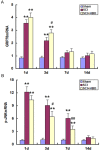Effects of hyperbaric oxygen on glucose-regulated protein 78 and c-Jun N-terminal kinase expression after spinal cord injury in rats
- PMID: 26064220
- PMCID: PMC4443054
Effects of hyperbaric oxygen on glucose-regulated protein 78 and c-Jun N-terminal kinase expression after spinal cord injury in rats
Abstract
Spinal cord injury (SCI) is not only devastating but also represents a public health burden for society. Endoplasmic reticulum stress (ERS) is implicated in secondary injury following damage to the SC. Hyperbaric oxygen (HBO) treatment can improve the recovery of motor function after SCI, but the effect of HBO on the ERS response is unknown. This study tested the hypothesis that HBO treatment protects against secondary SCI by inhibiting the ERS response via regulation of glucose-regulated protein (GRP) 78 and c-Jun N-terminal kinase (JNK) expression. Rats were randomly assigned to sham, SCI, and SCI + HBO groups and the extent of neuronal damage and neurological recovery were evaluated 1, 3, 7, and 14 days after surgery. GRP78 and JNK expression was evaluated by immunohistochemical, western blot, and real-time reverse transcription-polymerase chain reaction analyses, while caspase-3 activation was evaluated by enzyme-linked immunosorbent assay. SCI resulted in an upregulation in GRP78 and JNK expression compared to sham-operated animals. HBO treatment increased GRP78 level, but decreased that of JNK and suppressed caspase-3 activation as well as neuronal damage relative to the SCI group. In addition, hind limb motor function was improved by HBO treatment. HBO treatment reduces SCI-induced neuronal death and promotes the recovery of neurological function recovery by inhibiting the ERS response via modulation of GRP78 and JNK expression levels.
Keywords: Hyperbaric oxygen; c-Jun N-terminal kinase; glucose-regulated protein 78; spinal cord injury.
Figures






Similar articles
-
Hyperbaric Oxygen Treatment Protects Against Spinal Cord Injury by Inhibiting Endoplasmic Reticulum Stress in Rats.Spine (Phila Pa 1976). 2015 Dec;40(24):E1276-83. doi: 10.1097/BRS.0000000000001056. Spine (Phila Pa 1976). 2015. PMID: 26192724
-
Effect of VEGF and CX43 on the promotion of neurological recovery by hyperbaric oxygen treatment in spinal cord-injured rats.Spine J. 2014 Jan;14(1):119-27. doi: 10.1016/j.spinee.2013.06.084. Epub 2013 Oct 31. Spine J. 2014. PMID: 24183749
-
Hyperbaric oxygen alleviates experimental (spinal cord) injury by downregulating HMGB1/NF-κB expression.Spine (Phila Pa 1976). 2013 Dec 15;38(26):E1641-8. doi: 10.1097/BRS.0000000000000005. Spine (Phila Pa 1976). 2013. PMID: 24335635
-
Analysis the effect of hyperbaric oxygen preconditioning on neuronal apoptosis, Ca2+ concentration and caspases expression after spinal cord injury in rats.Eur Rev Med Pharmacol Sci. 2018 Jun;22(11):3467-3473. doi: 10.26355/eurrev_201806_15172. Eur Rev Med Pharmacol Sci. 2018. PMID: 29917200
-
Hyperbaric Oxygen Therapy and Tissue Regeneration: A Literature Survey.Biomedicines. 2022 Dec 6;10(12):3145. doi: 10.3390/biomedicines10123145. Biomedicines. 2022. PMID: 36551901 Free PMC article. Review.
Cited by
-
Synergistic neuroprotective effects of hyperbaric oxygen and methylprednisolone following contusive spinal cord injury in rat.J Spinal Cord Med. 2022 Nov;45(6):930-939. doi: 10.1080/10790268.2021.1896275. Epub 2021 Apr 8. J Spinal Cord Med. 2022. PMID: 33830902 Free PMC article.
-
A review on the neuroprotective effects of hyperbaric oxygen therapy.Med Gas Res. 2021 Apr-Jun;11(2):72-82. doi: 10.4103/2045-9912.311498. Med Gas Res. 2021. PMID: 33818447 Free PMC article. Review.
-
Matrine protects PC12 cells from lipopolysaccharide-evoked inflammatory injury via upregulation of miR-9.Pharm Biol. 2020 Dec;58(1):314-320. doi: 10.1080/13880209.2020.1719165. Pharm Biol. 2020. PMID: 32297823 Free PMC article.
References
-
- Rowland JW, Hawryluk GW, Kwon B, Fehlings MG. Current status of acute spinal cord injury pathophysiology and emerging therapies: promise on the horizon. Neurosurg Focus. 2008;25:E2. - PubMed
-
- Penas C, Guzmán MS, Verdu E, Forés J, Navarro X, Casas C. Spinal cord injury induces endoplasmic reticulum stress with different cell-type dependent response. J Neurochem. 2007;102:1242–1255. - PubMed
-
- Hayashi T, Saito A, Okuno S, Ferrand-Drake M, Chan PH. Induction of GRP78 by ischemic preconditioning reduces endoplasmic reticulum stress and prevents delayed neuronal cell death. J Cereb Blood Flow Metab. 2003;23:949–961. - PubMed
LinkOut - more resources
Full Text Sources
Research Materials
Miscellaneous
